|
THE
GOLD MEDAL CORNER, by Bill Crider
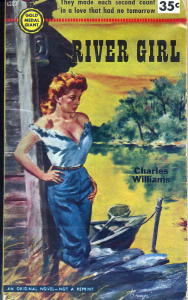 Here’s the back cover blurb: The author of the hour!
He wrote HILL GIRL for you. He wrote BIG CITY GIRL for you. Now he has written for you his third and greatest GOLD MEDAL NOVEL: RIVER GIRL – the story of a man and a woman who met and knew instantly that not all the world could tear them apart. If you already know that the guy who wrote those books for you is Charles Williams, then you probably already know that he, like Dan J. Marlowe from last time, is one of the people who belongs in the Gold Medal Pantheon. River Girl was a little longer than a lot of the other books Gold Medal was publishing in 1951, so it was issued as a Gold Medal Giant and priced at 35 cents instead of a quarter. But it was still a bargain. It’s the story of Jack Marshall, who’s working as a deputy sheriff in a small southern town of the kind Williams writes about so well. Jack didn’t set out to become corrupt. It just happened gradually, and even at that, we know he’s not all bad. He just needs a chance to escape from the life he’s trapped in. And the woman of the title, Doris, seems to be the way out he’s been looking for. But if you’re familiar with Williams’s work, you know that things seldom go well for his protagonists, and this time is no exception. First, somebody is killed. Then, although Jack seems to have a perfect plan, little things start going wrong. One of the pleasures of reading the book is to find out what these little things are. Williams is a terrific plotter, so while you may guess some of them, I doubt you’ll guess all of them. The final chapter, only two pages long, is just right. Couldn’t be improved upon. The tone, pacing, and atmosphere of the whole book are pitch-perfect. No wonder River Girl is one of my favorite Charles Williams books. A Touch of Death is another good one (but then there’s no such thing as a bad Charles Williams novel). Lee Scarborough is a former college football player, a one-time star who’s now struggling just to get by. He meets a woman who says her name is Diana James, and she has a plan to get her hands on a lot of money if she can find the right helper. Lee’s her pigeon, and before long he’s met another woman, Madelon Butler, who’s about the toughest babe you’ll find in fiction. And she’s smart, too, a lot smarter than Lee, who, as things move along always believes he’s always one step ahead of her, only to discover, far too late, that he never even got out of the starting blocks. Great stuff, and the last few lines, like the ones in River Girl, are devastating. 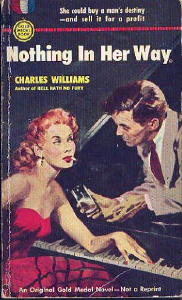 Here’s another back-cover
blurb for you: Here’s another back-cover
blurb for you: More than a million readers bought his
HILL GIRL.
A million more bought his BIG CITY GIRL. More millions are snapping up his HELL HATH NO FURY. Here’s the latest Charles Williams classic of suspense, NOTHING IN HER WAY. It’s easy to see that Williams was selling a heck of a lot of books, and with good reason. Nothing in Her Way is a little different from the first two books I mentioned, as it’s about a series of con games, with so many double crosses, triple crosses, and quadruple crosses that it will almost certainly keep you off balance all the way through. You may think you know who’s doing what to whom, but Williams is consistently surprising. Even at the end, you might not be sure who wins, but you’ll know who the loser is, another guy who trusted a woman who’s a lot colder and smarter and more ruthless than he’ll ever be. And another great ending, too. Gold Medal Bonus: And now for something completely different. Williams could also do comedy. He wrote a couple of Gold Medal called The Diamond Bikini and Uncle Sagamore and his Girls that can be called crime novels only if you stretch the definition a little. Call them crime novels by way of Huckleberry Finn and John Faulkner’s Cabin Road series (and speaking of under-appreciated, nearly forgotten Gold Medal writers, please don’t overlook John Faulkner, William’s brother). Williams’ two tales are narrated by a youngster named Billy, though the criminous shenanigans are perpetrated by his Uncle Sagamore and his father, two guys who are directly descended from Mark Twain’s King and Duke (a fact I could prove by sophisticated literary analysis, but I’m going to spare you that). 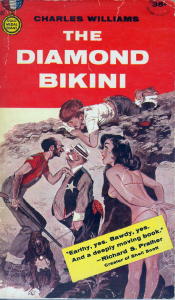 Non-Gold Medal Bonus #1: While you should read all Williams’ Gold Medal Books, he wrote some dillies for Dell First Editions, too. All the Way is one of his very best. The Big Bite. Talk of the Town. Just pick one. And don’t pass up And the Deep Blue Sea, a Signet book that was nominated for an Edgar. Non-Gold Medal Bonus #2: Any of Williams’ hardcovers. Some people think the sailing novels like The Sailcloth Shroud and Dead Calm are Williams’ best work. They could be right, but I, of course, prefer the paperbacks. And of the hardcovers, I prefer the reprint title Gulf Coast Girl (originally Scorpion Reef). I mean, anybody can tell which title is the best, right? And while I’ve never seen the hardcover dust jacket, I’m betting it doesn’t come within a mile of the Dell cover for the reprint. You can hardly go wrong with any Gold Medal book by Charles Williams. Get one of those I mentioned above or any of the others. Go Home Stranger, The Long Saturday Night, Man on the Run. Start anywhere you want to. Just be sure to start. CHARLES WILLIAMS - A Bibliography by Steve Lewis US editions only: 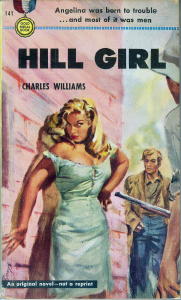 Hill Girl. Gold Medal #141, pb, 1951. Big City Girl. Gold Medal #163, pb, 1951. River Girl. Gold Medal Giant #G207, pb, 1951. Hell Hath No Fury. Gold Medal #286, pb, February 1953. Reprinted: Nugget, magazine, January 1957 [abridged]; Vintage Crime [Black Lizard], trade pb, 1981, as The Hot Spot. Nothing in Her Way. Gold Medal #340, pb, October 1953. “The Strike.” Cosmopolitan, magazine, January 1954. Go Home, Stranger. Gold Medal #371, pb, February 1954. “And Share Alike.” Manhunt, magazine, August 1954. [Condensed version of A Touch of Death. See below.] A Touch of Death. Gold Medal #434, pb, October 1954. “Flight to Nowhere.” Manhunt, magazine, September 1955. [Condensed version of Scorpion Reef. See below.] Reprinted in The Mammoth Book of Pulp Fiction, Maxim Jakubowski, ed., Carroll & Graf, 1996. Scorpion Reef. Macmillan, hc,1955. Reprinted: Dell #898, pb, 1956; Dell D-337, pb 1960, both as Gulf Coast Girl; Pocket, pb, 1972, as Scorpion Reef. “The Big Bite.” Manhunt, magazine, July 1956. [Condensed.] The Big Bite. Dell First Edition #A114, pb, 1956. Reprinted: Pocket, pb, 1973. The Diamond Bikini. Gold Medal #s607, pb, September 1956. Reprinted: Thorndike, trade pb [large print], 1990. “Operation.” Cosmopolitan, magazine, February 1957. [Condensed version of Girl Out Back. See below; note that the British editions of the latter were entitled Operator.] Girl Out Back. Dell First Edition #B114, pb, February 1958. “Stain of Suspicion.” Cosmopolitan, April 1958. [Condensed version of Talk of the Town; later reprinted under this magazine title. See below.] 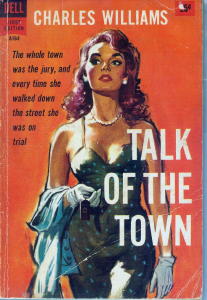 Talk of
the Town. Dell #A164, pb, 1958. Reprinted
as Stain of Suspicion,
Pocket, pb, 1973. Talk of
the Town. Dell #A164, pb, 1958. Reprinted
as Stain of Suspicion,
Pocket, pb, 1973.All the Way. Dell First Edition #A165, pb, September 1958. Man on the Run. Gold Medal #822, pb, November 1958. Uncle Sagamore and His Girls. Gold Medal #s908, pb, 1959. Aground. Viking press, hc, July 1960. [Series character: John Ingram]. Appeared simultaneously in Cosmopolitan, magazine, July 1960. [Condensed]. Reprinted: Mystery Guild [book club hc] n.d.; Crest #471, pb, 1961; Pocket, pb, October 1971. The Sailcloth Shroud. Viking Press, hc, 1960. Previously appeared in Cosmopolitan, magazine, Serptember 1959 [condensed]. Reprinted: Mystery Guild [book club hc], n.d.; Dell #D410, pb, March 1961; Pocket, pb, November 1972; Perennial, pb, 1983. The Long Saturday Night. Gold Medal #s1200, pb, March 1962. Previously appeared in Cosmopolitan, magazine, October 1961 [condensed]. Reprinted: Penguin, pb, 1983, as Confidentially Yours. “Pacific Honeymoon.” Cosmopolitan, magazine, July 1963. [Condensed version of Dead Calm. See below.] Dead Calm. Viking, hc, 1963. [Series character: John Ingram]. Reprinted: Mystery Guild [book club hc], n.d.; Avon #1255, pb, 1965; Pocket, pb, 1971; Perennial, pb, 1983. The Wrong Venus. New American Library, hc, 1966. Previous appeared in Cosmopolitan, magazine, September 1966 [condensed]. Reprinted: Signet, pb, February 1970; Perennial, 1983. And the Deep Blue Sea. Signet, pb, March 1971. Nominated for an Edgar in the category of Best Paperback Mystery, 1972. [Winner: For Murder I Charge More, by Frank McAuliffe.] Man on a Leash. G. P. Putnam’s Sons [Red Mask Mystery], hc, 1973. Reprinted: Mystery Guild [book club hc], n.d. Comment by Ed Lynskey: “Nona Tyson, an assistant to Steven Spielberg who also helped Williams out on THE HOT SPOT script, is uncredited for helping him on this last book. I read somewhere that they had married, but I never substantiated it for a fact. Charles Williams also had one final book that was never published, but I never tracked down any additional information about it.” Note: Besides the pair of “Uncle Sagamore” books that discussed by Bill, the bibliography points out that two of Williams’s other books had recurring characters: From a description obtained from the Crest paperback version of Aground: “Ingram had been around plenty. He knew almost everything there was to know about boats and almost as much about babes. Trouble was he was honest. So when this con artist set him up as patsy in a big-time yacht swindle, with matching murder rap, he didn't suspect a thing. Until the cops moved in. Ingram knew the only way to find the joker who tied him into this deal was to cherchez la femme. Getting there was half the fun. She was the owner of the missing yacht. A gorgeous blonde tomato. Salty as hell and ripe for action. She had just what he wanted. And vice versa. Only they shoulda stood in bed. Because the missing yacht was really a booby trap – complete with slab-happy hoods and a cargo of sudden death.” From a description obtained from the Pocket paperback edition of Dead Calm: “John and Rae Ingram – the two characters who so fascinated readers of Aground – are alone on their honeymoon yacht in the mid-Pacific when they are becalmed. It could have been idyllic. But they are soon forced to abandon any thoughts of solitary bliss. Nearby, a ship is sinking. They rescue its lone passenger, a handsome young man, who claims he has had to bury his wife and another couple, dead from food poisoning. But suspicion gnaws at Ingram. And in no time he and his wife are catapulted into a terrifying struggle for their lives.” Comment: For an author so well-known for the paperback originals he wrote, all of them very collectible, it seems strange that his final book never appeared in paperback, but curiously enough, it is so. 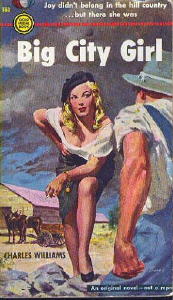 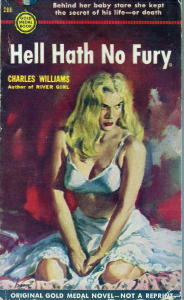 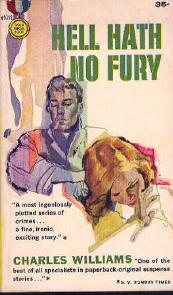 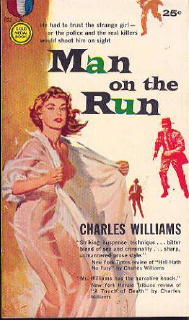 FILMS – 1960 The 3rd Voice. Based on the novel All the Way. Stars: Edmond O’Brien, Julie London, Laraine Day, Olga San Juan. Note: In M*F 40, Dan Stumpf suggested that Williams book may have been the first paperback original to have been the basis of a movie. It is now over a year later, and no one yet has refuted the claim. 1963. Peau de Banane [Banana Peel]. French. Based on the novel All the Way. Stars: Jeanne Moreau, Jean-Paul Belmondo. 1964. Le Gros Coup. French. Based on the novel The Big Bite. Stars: Emmanuelle Riva, Hardy Krüger. Note: Hubin refers to this film as AVEC UN ELASTIQUE. 1964. Les Félins [a/k/a Joy House]. French. Based on the novel Joy House, by Day Keene. Williams credited as co-screenwriter, plus additional dialogue. Stars: Alain Delon, Jane Fonda, Lola Albright, Sorrell Booke. 1965. L’Arme à Gauche. [a/k/a The Dictator’s Guns]. French. Based on the novel Aground; Williams credited as co-screenwriter. Stars: Lino Ventura, Sylva Koscina, Alberto de Mendoza. 1968. Don’t Just Stand There! Based on the novel The Wrong Venus; Williams was also the screenwriter. Stars: Robert Wagner, Mary Tyler Moore, Glynis Johns, Harvey Korman. 1968. The Pink Jungle. Based on the novel Snake Water by Alan Williams; Charles Williams was the screenwriter. Stars: James Garner, Eva Renzi, George Kennedy. 1970. The Deep. Based on the novel Dead Calm. Screenwriter: Orson Welles. Stars: Michael Bryant [John Ingram], Laurence Harvey, Oja Kodar [Rae Ingram], Jeanne Moreau, Orson Welles. The movie was never finished after Harvey’s death during filming. 1971. Fantasia Chez les Ploucs. [Fantasia Among the Squares.] French. Based on the novel The Diamond Bikini. Stars: Lino Ventura, Mireille Darc, Jean Yanne. 1975. The Man Who Would Not Die [a/k/a Target in the Sun]. Based on the novel The Sailcloth Shroud. Co-screenwriter: George Chesbro. Stars: Dorothy Malone, Keenan Wynn, Aldo Ray. 1983. Vivement Dimanche! [a/k/a Confidentially Yours] French. Based on the novel The Long Saturday Night. Directed by François Truffaut. Stars: Fanny Ardant, Jean-Louis Trintignant. 1989. Dead Calm. Based on the novel. Stars: Nicole Kidman [Rae Ingram], Sam Neill [John Ingram], Billy Zane. 1989. Mieux Vaut Courir. French TV movie. Based on the novel Man on the Run. Stars: Christian Clavier, Carmen Maura. 1990. The Hot Spot. Based on the novel Hell Hath No Fury. Co-screenwriters: Charles Williams & Nona Tyson. Director: Dennis Hopper. Stars: Donald Johnson, Virginia Madsen, Jennifer Connelly. 1990. La Fille des Collines. French. Based on the novel Hill Girl. Stars: Nathalie Cardone, Florent Pagny. UPDATE. From Jamie Sturgeon: As a keen Charles Williams reader (and collector), I found the article on him very interesting. In the list of films there is one missing, the TV pilot for Cannon, based on Talk of the Town (Stain of Suspicion in my hardcover copy)). Now I know www.imbd.com says Edward Hume is the writer, but if you compare the names of the characters, many of those in the book are kept in the film: Georgia Langston (Diane Langston in the film), Kelly Redfield, Magruder, Calhoun etc etc. The plot is definitely the same, though I admit it’s a long time since I read the book. I’m going to read it again now – now if I can only track down a copy of Cannon. I wonder if Charles Williams got paid for it? References: Bill Contento, The FictionMags Index Michael L. Cook, Monthly Murders Allen J. Hubin, Crime Fiction IV. www.imdb.com Ed Lynskey “The High Seas of Charles Williams” http://www.allanguthrie.co.uk/4/ Bill Crider’s column and the accompanying bibliography first appeared in Mystery*File 47, Feb 2005. From the letter column of the never-published Mystery*File 48: 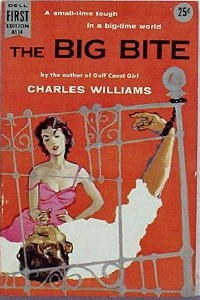 DAN STUMPF (Ohio) DAN STUMPF (Ohio)Thanx for the latest Mystery*File, and may I say again what an outstanding job you do with this. Bill Crider’s comments on Charles Williams cannot be improved upon – as usual with Crider’s writing – but I might note as a sidelight that has always interested me: the plot of Williams’ Gold Medal A Touch of Death was 90% recycled in his Dell paperback The Big Bite. Reading them both is like listening to variations on a theme. Many writers recycle their plots shamelessly (P.G. Wodehouse and Ian Fleming come to mind) but this is the only time I found it in Williams. JOHN FRASER (Nova Scotia) Charles Williams’ suicide, with what it suggests about the misery of his final years, is so SAD. It's good having your bibliography as well as Bill Crider’s rightly enthusiastic comments, especially your list of films, all but three of which titles were unfamiliar to me. But why DID he kill himself? I’ve now found my unprepossessing Canadian-published copy of The Big Bite and compared it with A Touch of Death. The Big Bite is much the better of the two. Both involve a murdered husband, both have a larcenous, cynical, failed-football-pro narrator and a smarter, classier woman adversary, and both leave the narrator hanging by his fingertips at the end. But they’re still very different books, though not as different as Reservoir Dogs was from City on Fire, from which it allegedly derived. My own take on the matter is that in The Big Bite,Williams got things right that he’d only sketched or sensed as possibilities in A Touch of Death, possibly because at Macmillan he’d already upped his own standards in hardcover with the marvellous Scorpion Reef. The settings in The Big Bite are fuller, the characters, including a male accomplice of the woman, better developed, their plottings and counter-plottings more ingenious, the narrator’s relationship with the woman less linear. A Touch of Death, with its reiterated pattern of the man saying dumb aggressive things and the woman remaining coolly unreachable, indeed feels like the expanded short story that it was. _____________________________________ YOUR COMMENTS ARE WELCOME:
Copyright © 2005 by Steve
Lewis. All rights reserved to contributors.
|